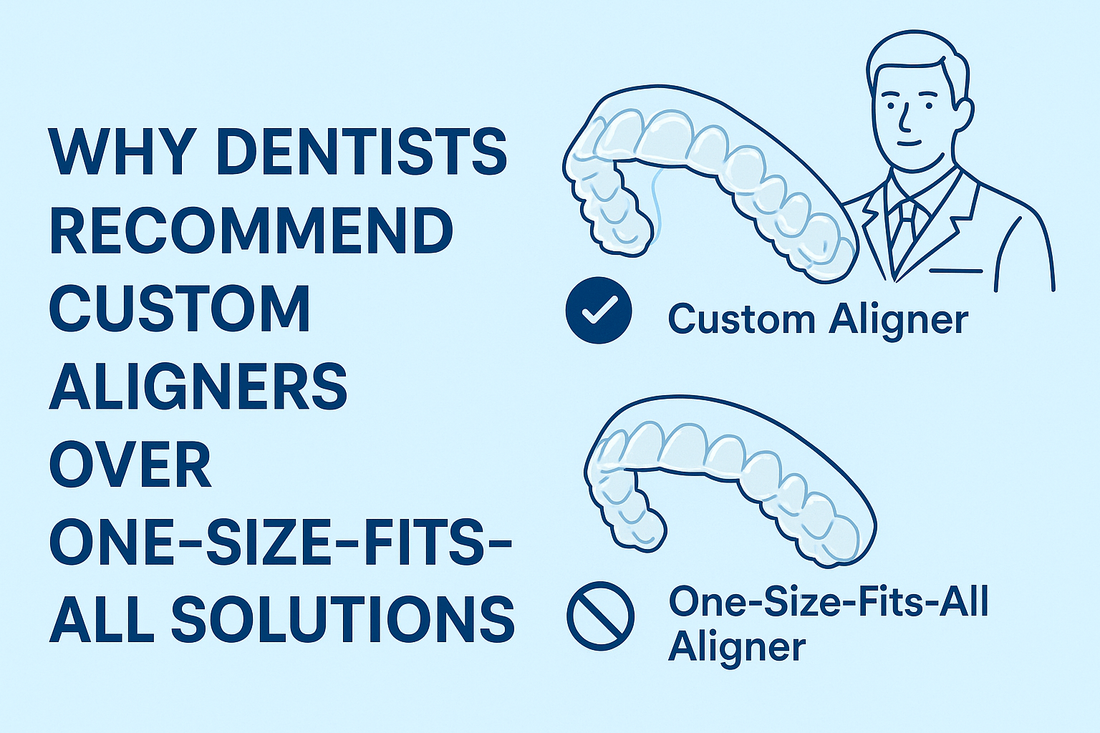Why Dentists Recommend Custom Aligners Over One-Size-Fits-All Solutions

Share
Introduction
In the evolving landscape of orthodontic care, the demand for discreet, effective, and comfortable teeth straightening solutions has surged. While over-the-counter (OTC) or generic one-size-fits-all aligners may appear convenient and cost-effective, dentists and orthodontists overwhelmingly advocate for custom aligners. These tailored solutions are clinically designed to meet individual needs, offering a host of advantages in terms of comfort, precision, safety, and long-term results.
In this blog, we’ll explore why dental professionals consistently recommend custom-made clear aligners and what makes them a superior choice over mass-produced alternatives.
1. Precision Fit for Optimal Results
Custom aligners are developed using 3D digital scans, impressions, or intraoral images of the patient’s teeth. This personalized mapping ensures a snug, precise fit that facilitates controlled tooth movement.
✅ Result: Each aligner in the treatment series moves the teeth incrementally, following a pre-approved treatment plan created by licensed orthodontists or dentists.
In contrast, one-size-fits-all aligners are made generically and cannot account for the unique shape, alignment, or bite of an individual’s teeth, often resulting in poor fit and ineffective treatment.
2. Clinician-Guided Treatment Planning
Custom aligners come with an orthodontist-supervised treatment plan tailored to the patient's dental anatomy and goals. The movement of teeth is carefully planned to avoid complications and deliver predictable results.
✅ Professional oversight also allows for mid-course corrections, refinements, and post-treatment retainers—an essential part of ensuring long-term smile stability.
Generic aligners typically lack professional monitoring, increasing the risk of unsupervised movement, which can worsen bite problems or cause permanent damage.
3. Better Comfort and Oral Health
Because they’re crafted specifically for a patient’s mouth, custom aligners have smooth edges, uniform thickness, and minimal bulk. This ensures:
-
Reduced irritation to the gums and cheeks
-
Better speech comfort
-
Easier removability
One-size options are often made from inferior materials with poor edge finishing, causing discomfort and in some cases, oral injuries.
4. Higher Success Rates and Predictability
Dentists rely on advanced treatment planning software to visualize outcomes and simulate tooth movements before beginning treatment. This data-driven approach results in:
-
Higher accuracy
-
Realistic expectations
-
Faster treatment timelines
Generic aligners lack such planning tools, resulting in uncertain outcomes and frequent user dissatisfaction.
5. Tailored Duration and Movement Control
Custom aligner programs can adjust the force, timing, and sequence of tooth movement based on clinical guidelines. Treatment duration is optimized—usually ranging between 4 to 18 months depending on complexity.
✅ Nighttime-only aligners, dual-arch alignment, and mid-treatment refinements are all options with custom care.
With one-size aligners, users are given a generic tray with no control over force or movement progression, often prolonging treatment or making it ineffective.
6. Safety and Risk Management
Improper or unmonitored tooth movement can lead to:
-
Gum recession
-
Root resorption
-
Jaw pain
-
Bite misalignment
Custom aligners eliminate such risks through regular check-ins, diagnostic evaluations, and X-rays if needed. Generic aligners lack this medical oversight, posing serious health risks.
7. Long-Term Smile Stability
Once treatment concludes, custom aligner programs include retainers and post-care advice to ensure results are maintained.
Without this support, many patients using OTC aligners suffer relapse, with teeth shifting back to their original positions within months.
8. Integration with Broader Dental Care
Custom aligner programs often work alongside other dental treatments like whitening, cavity fillings, or gum treatments. Dentists create comprehensive care plans that align aesthetics with oral health.
A one-size approach ignores these nuances and may interfere with other treatments.
9. Regulatory Compliance and Quality Materials
Custom aligners are often FDA-cleared, CE-certified, and made from medical-grade thermoplastic materials. This guarantees:
-
Biocompatibility
-
Durability
-
Transparency (aesthetics)
OTC alternatives may not meet such rigorous standards, and quality may vary across providers.
10. Support and Education
With custom treatment, patients receive guidance, digital previews, FAQs, and support from trained staff. This ensures better compliance and understanding throughout the process.
Generic options typically lack after-sales support or professional assistance, leaving users confused and vulnerable to complications.
Conclusion
While the allure of one-size-fits-all clear aligners may seem appealing in terms of cost or convenience, the risks far outweigh the benefits. Dentists recommend custom aligners because they are safer, more effective, and tailored to your unique smile goals.
A healthy, straight smile is a long-term investment—trusting a dental professional and opting for a customized approach ensures the results are not just visible, but lasting.
 EU
EU








